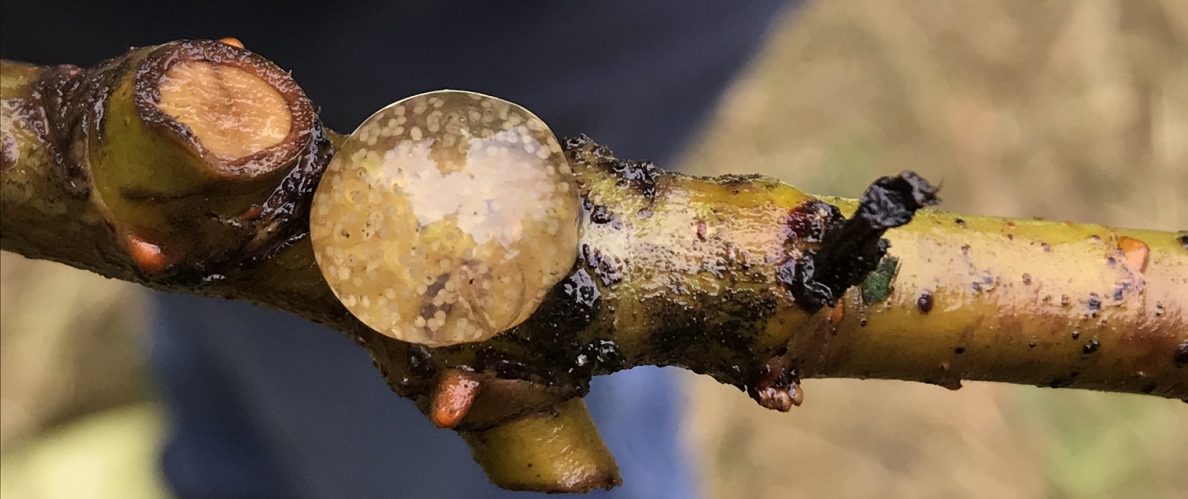
My kitchen is filled with fruit at the moment- fruit that I am dehydrating, fruit that I am eating and fruit that I will either can or use to make jam. Today, fruit flies showed up in my kitchen in force. When I was frustrated with these tiny insects last year, I decided to learn more about them. I shared the information I learned on this blog. Since I assume that I’m not the only person who is dealing with fruit flies right now, I am going to reprint that post below.
*****
I do my best not to kill spiders, bugs, and insects but fruit flies can be so overwhelming. Even when I put my fruit in the refrigerator, at some point during the summer I usually end up resorting to trapping them with vinegar. Perhaps because the summer was so warm this year, there were more fruit flies than normal. Once, when I opened my outdoor compost bin, the swarm that emerged was so huge I could barely breathe. One day, I visited a friend’s house only to find a big swarm of fruit flies in her kitchen, even though there didn’t seem to be anything present in the kitchen to draw them.
During the last few months, I have posted interesting facts about ants, aphids and slugs on this blog. I decided to do the same for fruit flies. I was astounded at what I learned about them.
- Fruit flies have red eyes and tan bodies. On their abdomens, there are black bands.
- Fruit flies become .098 inches in length.
- They flap their wings 220 times per second.
- Their eyes have 760 individual lenses. They use 2/3 of their brains for visual processing.
- Fruit flies live 8 to 10 days. During that time females may lay 500 eggs. (One article said they may lay up to 2000!)
- Fruit flies are drawn to decaying fruits and vegetables, as well as greasy items, in garbage dumps, trash cans, restaurants and homes.
- They are also drawn to anything that is fermenting. They love beer and wine.
- They are considered nuisance pests but they can transmit diseases.
- Do not eat fruits that have rotten parts as they may contain fruit fly eggs and disease.
- People who have pet geckos, chameleons, frogs and praying mantises often breed fruit flies to feed them. They must also be a food source to many creatures in the wild.
- Fruit flies have only four chromosomes but those four are similar to human chromosomes.
- Fruit flies are used in genetic research and also for studying evolution and neurobiology.
- Seventy-five percent of genetically linked human diseases can be induced and examined in fruit flies.
- Fruit flies are used in Parkinsons, Alzheimers, aging, cancer, immunity, alcohol and drug abuse research.
- Fruit flies originated in West Africa and then spread to Europe. They probably arrived in North America on slave ships.
- In 1995 three scientists who used fruit flies in their experiments won the Nobel Peace Prize!
Here is an interesting video of the developmental stages of a fruit fly’s life.
Well, the fruit fly may be considered a nuisance pest, but it is obvious that they also provide important services to this world. I will never look at them the same again!
References:
5 Things You Didn’t Know about Fruit Flies
Drosophila melanogaster: Common Fruit Fly
Basic Fruit Fly Facts
Fruit Flies
Top Ten Fascinating Facts about Fruit Flies
Fruit Fly Photo Credit: Wikipedia

This makes me so happy! Drosophila melanogaster (the fruit fly) is one of the model organisms of genetics research, and I actually worked with thousands of them over the 2015/2016 school year for my senior research project. Thanks for giving my disgusting little friends some attention! You can read about my research project if you want! 🙂 Here’s the link: http://www.genetics-gsa.org/genetics/2016/abstracts/cgi-bin/absc.pl?u=7EC190C8ED4B11E5B4C75B5EB4901BDC
LikeLiked by 2 people
I’m so glad you saw my post. I don’t understand the contents of the abstract but it was very interesting to see! Thanks so much for sharing it with me.
LikeLiked by 1 person
I’m not sure if I completely understand it either! Haha! We essentially studied global variations in the Y chromosome. Pretty cool stuff! 🙂
LikeLiked by 2 people
I’m glad to have “met” someone who has participated in that research!
LikeLiked by 2 people
Wow, thanks for sharing this info. Amazing to hear how much they contribute to research and our physical well being. And the number of lenses they have is staggering, not to mention the amount of their brains dedicated to sight! No wonder their eyes are so big. And I still get grossed out by them…
LikeLiked by 1 person
They don’t so much gross me out but they definitely annoy me, a lot. Did you read Abbie’s comments? They were a nice surprise. I think you would find them interesting too.
LikeLike
Thanks for the great video. what lovely, energetic creatures, who pack a lot into such a short life.
LikeLiked by 1 person
I have found it very interesting to learn more about the creatures we consider pests.
LikeLike
I still don’t like those pesky little bugs.
LikeLiked by 1 person
I don’t either. But it’s nice they do good things in addition to annoying me! 🙂
LikeLike
I’ve only seen fruit flies since last week at home and definitely due to the heat…still mid 80’s. I cannot get over how hot it is compared to out west.
LikeLiked by 1 person
This week it is going to be in the 60’s most of the time. This is much more like our “normal” weather than the last few years.
LikeLike
You have our “old” normal…can’t wait for 60’s
LikeLiked by 1 person